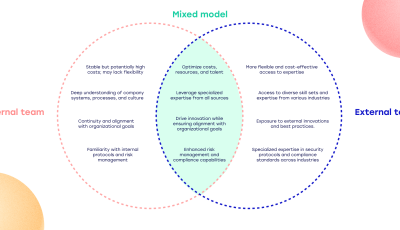At Helmes, we create value for our partners with world-class software development teams. Our team model has been perfected over years of partnerships with hundreds of clients and, in essence, refers to a squad of qualified professionals who work together as a well-oiled machine in a supportive work environment.
Before applying for the position of team lead at Helmes, I spoke to several people who worked for the company. While everyone had only good things to say about their work environment, one comment kept repeating in the conversations: “That said, every team at Helmes is unique.” This left me somewhat puzzled but all the more curious to find out more about the company.
At Helmes, hiring is value-based
First, candidates are evaluated for a match of values, with qualities like caring, courage, and efficiency assessed from different aspects. Only then do skills and competencies come into consideration. The hiring process for key positions involves three rounds of interviews, during which I learned a lot about the company and also about methodical software development in general.
From my perspective, it would have been time well spent even if the interviews had not led to a job offer.
Once the overall match was established, I was introduced to my team to see how I would fit into the particular team.
During onboarding, I had the opportunity to meet other team leads and learn how they work. This equipped me with a network of supportive colleagues, in addition to my direct superior, with whom I had (and still have) weekly 1:1 meetings to share any issues or ideas. As someone who loves sports, I also joined some of the many sports clubs at Helmes, connecting with more colleagues and further expanding my network.
The role of a team lead in Helmes
The reason why each team in Helmes is unique is because each client and project we work on is unique. Hence, teams need different competencies and team composition.
Yet, certain things apply universally across all teams. Within a team, the key responsibilities are divided among the core team members: typically, a team lead, lead developer, and analyst. Although one person can, in principle, fill multiple roles, it only happens in rare cases. So, while occasionally, a team lead must possess an excellent aptitude in software development or a specific technology, it’s not needed in most cases. Instead, a solid understanding of project management, the software development process, and leading people are the key skills needed to become a team lead.
In everyday work, the team lead is guided by three metrics – the team, the client, and business results – all of which are equally important.
The model could be compared to a three-legged stool – if one of the three legs is weak, the stool will be unstable. If one of the critical metrics stays in the red for a while, long-term success is impossible. On the other hand, if the team is happy, the client will likely be pleased with their work, and good business results will naturally follow, sparking a virtuous circle.
While business results are relatively straightforward to measure, monitoring the health of the team and client relations requires a more complex approach. To do that, we rely on fact-based measurements (surveys of team well-being, engagement, and client satisfaction) and more subjective perceptions picked up from conversations with colleagues and clients.
Building trust within the team
As a team lead, one of my responsibilities is having 1:1 conversations with each of my eight team members every two weeks. These conversations provide a space for taking a holistic look at work-related topics. Depending on individual preferences, we may have this chat at a pingpong table or in a more relaxed or formal setting. The main benefit of these conversations is building mutual trust – which forms the basis for everything else.
To strengthen the team spirit, we hold quarterly team-building events with another team, where we can get to know each other better and foster camaraderie through sports or creative activities.
As a team lead, my goal is to create conditions where every team member, as much as possible, can perform tasks that they are good at and enjoy doing. Not everyone needs to become equally good at everything – by knowing and trusting each other, we can cover for each other and function as a highly effective team. Developing our strengths will ultimately allow us to deliver more value together.
Going the extra mile for the client
Like every team, every client relationship is different, depending on the particular organization and its key people. Similarly to the team members, 1:1 meetings with the client are a good tool for gathering insights that may not necessarily be shared at client-team meetings and can serve as input for intervention or improvement.
While collaboration with the client is rooted in the Helmes Way model, we always adopt a personalized approach to a particular project. For example, in our team, we use a combination of Scrum and Kanban (which we call Scrumban) as the most efficient method of working for our purpose. Every two weeks, we hold retros where we discuss any technical and team-related questions (what we like or don’t like, what we should continue or discontinue, etc.), which helps us be maximally efficient both at the technical and team front and gather input for improvement.
What sets Helmes apart is our drive to go the extra mile and always provide the best solution for our clients. We believe in partnerships with the companies, many of whom we have worked with for over a decade. We take strong ownership of our projects, and instead of ticking off the boxes in a contract, we are not afraid to suggest solutions that might differ from the initial vision if they provide value to the client and their customers.
Best practices rooted in experience
Despite differences, all teams follow in their work the Helmes Way – a set of principles for building and operating a successful software development team, and Success Line, our approach to software development, both based on decades of collaboration with hundreds of clients.
As a new team lead, you don’t need to invent things from scratch but can build a successful team based on others’ experience, which gives you confidence and ideas to implement. I can sincerely say that each day, I feel that I have my back should I need any assistance – and I try to offer the same trust and support to others around me.
Helmes boasts a diverse team that includes young, enthusiastic team members as well as experienced colleagues who still share the same enthusiasm. Even more importantly, they all find the time for a rookie looking for their advice. To support cross-team learning, there are also company-wide professional communities – for instance, my favorite events are gatherings where we can exchange ideas with other team leads.
Culture of continuous learning
All team members (including team leads) have individual growth plans laying out their possible career paths for upcoming years. Progress toward the goals is discussed in annual development interviews, plus periodic check-ins throughout the year.
A growth mindset prevails throughout the organization, and all team members are offered ample opportunities for development as professionals and individuals. The in-house training program curated by the Learning and Development Unit focuses on different topics each semester. It includes training sessions by top experts on technical issues and more general ones, such as leadership, psychology, mental health, etc. In addition, new formats are constantly being tested and elaborated. For instance, this spring, I look forward to participating in the next edition of the Helmes group-wide mentorship program as a mentee.
Summing up my experience as a team lead at Helmes, I can now understand what my colleagues referred to in the conversations I had before joining the company. Indeed, each team at Helmes is unique. Yet, they all share a carefully balanced, comprehensive approach that sets them up for success. By balancing different aspects of business and not neglecting any of them, those success factors amplify each other. Only then can you unlock the route to long-term partnerships – both within the team and in client relationships.



